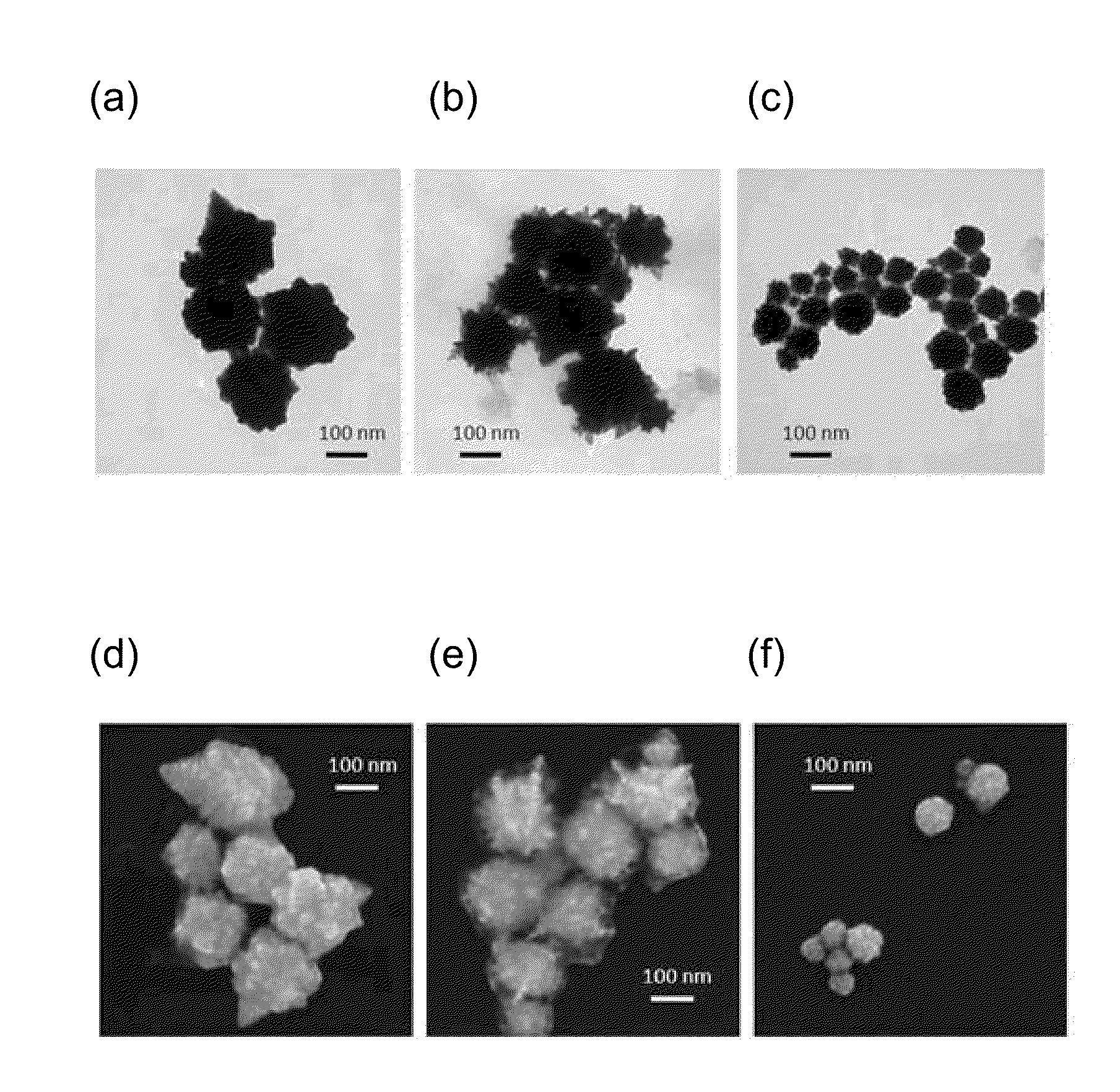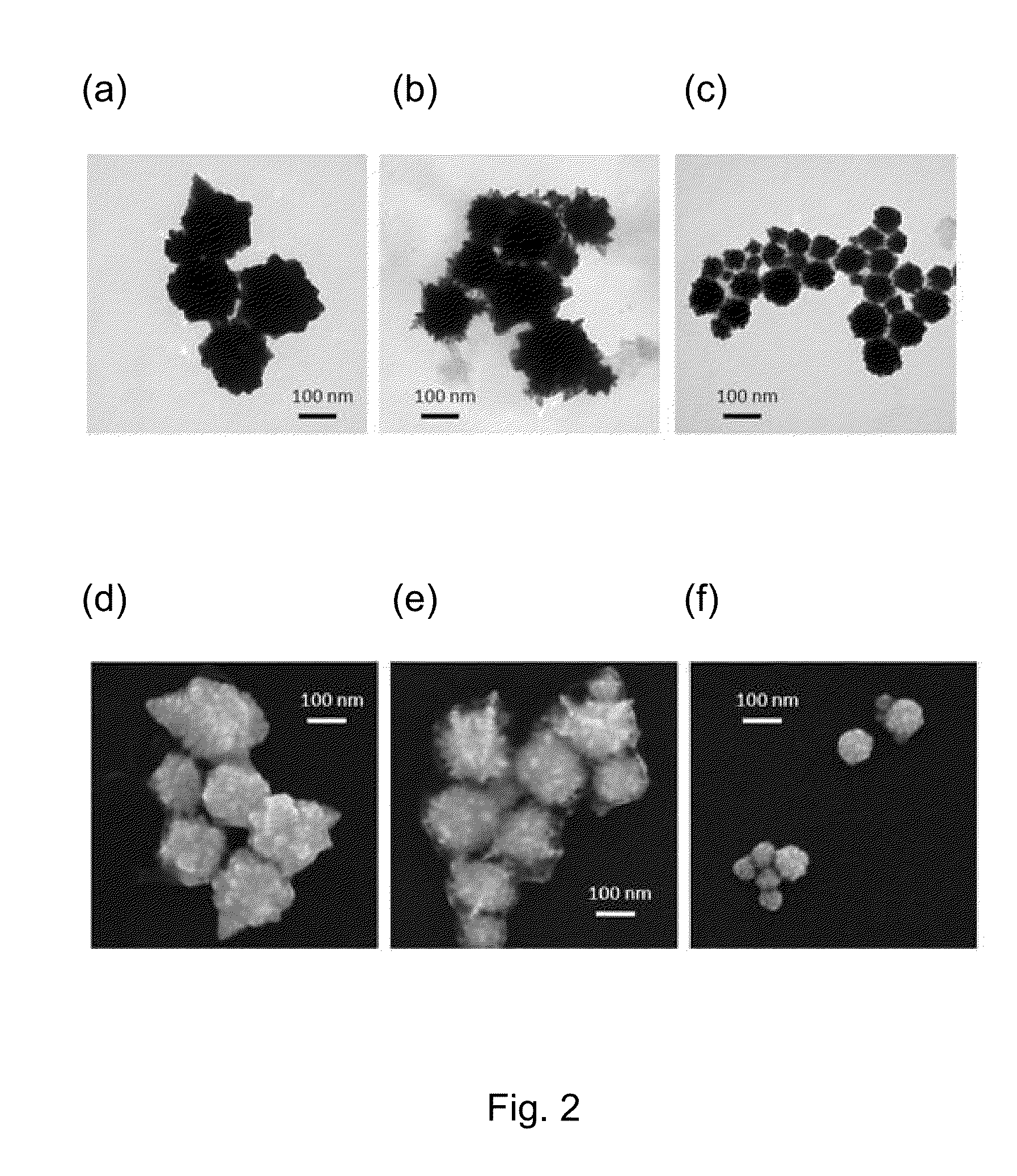Biocompartiple confeito-like gold nanoparticles, method for making the same, and their biomedical applications
a biocomponent and gold nanoparticle technology, applied in the field ofconfeitolike gold nanoparticles, can solve the problems of messy synthesis process and toxicology, long reaction time (at least several hours), and the practicability of nanorods, and achieve the effect of mass production
- Summary
- Abstract
- Description
- Claims
- Application Information
AI Technical Summary
Benefits of technology
Problems solved by technology
Method used
Image
Examples
example 1
Synthesis of the Gold Nanoparticles of the Invention
[0035]1.1 Materials and Methods
[0036]Sodium tetrachloroaurate(III) dihydrate (NaAuCl4.2H2O) and Pluronic F-127 (a polyethylene oxide-polypropylene oxide-polyethylene oxide block copolymer, PF127) were purchased from Sigma Aldrich Co. (USA). Anhydrous citric acid (Cit), polyvinylpyrrolidone (PVP, average M.W.: 58,000), sodium hydroxide (NaOH), and an aqueous 35 wt % solution of hydrogen peroxide (H2O2) were purchased from Acros Organics (USA). All chemicals were of reagent grade and were used without further purification. Ultrapure (Millipore Milli-Q) water with a resistivity of 18 MΩ·cm was used throughout all the syntheses and measurements in the study.
[0037]The synthesis of AuNPs was performed in a 50 cm3 glass vial at ambient temperature. Specifically, 4 cm3 of an aqueous 1 mM solution of NaAuCl4 was diluted with 28 cm3 of water, and a specified amount of the protecting agent was dissolved in the solution. An aqueous solution of...
example 2
Characterization of the Gold Nanoparticles of the Invention
[0044]2.1 Instruments
[0045]Transmission electron microscopy (TEM) images were acquired with a Hitachi H-7000 instrument at an accelerating voltage of 100 kV. The dispersion of AuNPs was poured on a carbon-coated copper grid, air-dried, and then used for the observation. The scanning electron microscopy (SEM) images were obtained with a JEOL JSM-6500F microscope. Ultraviolet-visible-near infrared (UV-vis-NIR) absorption spectra were recorded with a JASCO V-670 spectrophotometer with a quartz cell with a 1 cm light path.
[0046]2.2 Results
[0047]The AuNPs obtained in Example 1 were analyzed by visual observation and adequate apparatuses, including transmission electron microscopy (TEM), scanning electron microscopy (SEM), and UV-Vis-NIR absorption spectrometer.
[0048]It is known that the color of a gold nanoparticle solution depends on the size and shape of the nanoparticles. Individual small gold nanoparticles appear red while th...
example 3
Biomedical Applications
[0049]3.1 Instruments
[0050]Optical microscopic observation was performed using a confocal scanning laser microscope (Leica TCS SP5), and laser irradiations were carried out at 785 nm (1.07 W), 633 nm (10 mW), and 561 nm (10 mW) using the microscope system.
[0051]3.2 Synthesis and Surface-Modification of AuNPs
[0052]The confeito-like AuNPs of the invention were synthesized as in Example 1. To the dispersion of the confeito-like AuNP (40 cm3), an aqueous dispersion of folic acid (2 mM, 0.4 cm3) was added. The mixture was centrifuged at 3000 rpm for 10 min, and then, the fraction of 1 cm3 including the nanoparticles were redispersed to 8 cm3 to adjust the concentration to 0.5 mM (as Au). The spherical AuNPs and plate-like AuNPs for comparison were synthesized as follows:
[0053]Spherical AuNPs
[0054]An aqueous solution of NaAuCl4 (1 mM, 10 cm3) was boiled with stirring in a glass vial. To this solution, an aqueous solution of trisodium citrate (1 wt %, 1 cm3) was adde...
PUM
| Property | Measurement | Unit |
|---|---|---|
| Particle size | aaaaa | aaaaa |
| Nanoscale particle size | aaaaa | aaaaa |
| Nanoscale particle size | aaaaa | aaaaa |
Abstract
Description
Claims
Application Information
 Login to View More
Login to View More - R&D
- Intellectual Property
- Life Sciences
- Materials
- Tech Scout
- Unparalleled Data Quality
- Higher Quality Content
- 60% Fewer Hallucinations
Browse by: Latest US Patents, China's latest patents, Technical Efficacy Thesaurus, Application Domain, Technology Topic, Popular Technical Reports.
© 2025 PatSnap. All rights reserved.Legal|Privacy policy|Modern Slavery Act Transparency Statement|Sitemap|About US| Contact US: help@patsnap.com



